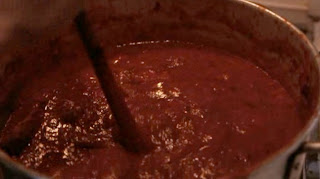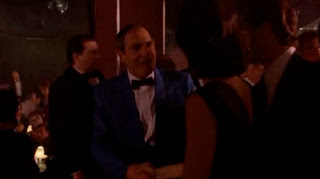Goodfellas Red
I discovered Goodfellas on Netflix Instant View last night. And as I was watching, something caught my eye that I'd never noticed before. Even though every other credit in the film is white, the title card is red.
 Since I just watched Raging Bull again last month, I knew that title card was red too — in fact, the red title card is the single use of color in an otherwise black and white film.
Since I just watched Raging Bull again last month, I knew that title card was red too — in fact, the red title card is the single use of color in an otherwise black and white film. Certainly, I was aware that Scorsese liked to play with the color red in his movies, particularly in the bar in Mean Streets. As Roger Ebert wrote in his "Great Movies" essay on the film, "The real world is shot in ordinary colors, but then Charlie descends into the bar run by his friend Tony, and it is always bathed in red, the color of sex, blood and guilt." And obviously, the bar in Goodfellas, The Bamboo Lounge, is lit with a similarly rosy glow:
Certainly, I was aware that Scorsese liked to play with the color red in his movies, particularly in the bar in Mean Streets. As Roger Ebert wrote in his "Great Movies" essay on the film, "The real world is shot in ordinary colors, but then Charlie descends into the bar run by his friend Tony, and it is always bathed in red, the color of sex, blood and guilt." And obviously, the bar in Goodfellas, The Bamboo Lounge, is lit with a similarly rosy glow: After the title card caught my eye, I became obsessed with the use of the color red in Goodfellas. Where previously, I'd only made note of it in the Bamboo Lounge scene, I began seeing it everywhere. Ebert describes the red of Mean Streets as a connection to "sex, blood, and guilt." In the book Gangster Priest: The Italian American Cinema of Martin Scorsese, Robert Casillo says the red in Goodfellas is associated with "blood, violence, suffering, and passion." But I think it's even more basic than that. Nearly every bad deed of all shapes and sizes is accented onscreen by a splash of bright vibrant red. When the wiseguys do something as bloody as beat a man to death for insulting one of their crew, they do in another barroom filled with crimson light:
After the title card caught my eye, I became obsessed with the use of the color red in Goodfellas. Where previously, I'd only made note of it in the Bamboo Lounge scene, I began seeing it everywhere. Ebert describes the red of Mean Streets as a connection to "sex, blood, and guilt." In the book Gangster Priest: The Italian American Cinema of Martin Scorsese, Robert Casillo says the red in Goodfellas is associated with "blood, violence, suffering, and passion." But I think it's even more basic than that. Nearly every bad deed of all shapes and sizes is accented onscreen by a splash of bright vibrant red. When the wiseguys do something as bloody as beat a man to death for insulting one of their crew, they do in another barroom filled with crimson light: And when he comes to in their trunk as they try to dispose of the body, the car's brake lights cast an impossibly strong red glare on De Niro and Pesci:
And when he comes to in their trunk as they try to dispose of the body, the car's brake lights cast an impossibly strong red glare on De Niro and Pesci: The sequence even ends with a highly unusual fade to red:
The sequence even ends with a highly unusual fade to red: When they have to go back six months later and dig up the body, things get even more abstract. It's as if the gangsters' sins have stained the film stock.
When they have to go back six months later and dig up the body, things get even more abstract. It's as if the gangsters' sins have stained the film stock. In the daytime, things get a little bit trickier. In these cases, Scorsese fills
In the daytime, things get a little bit trickier. In these cases, Scorsese fillsthe frame with bright red objects. Consider this shot, where Henry Hill (Liotta) teaches a guy not to touch his girl. There's the car, the toolbox, the flowers, even the house itself:
 While it is true that all of these examples so far have involved the violence that Casillo mentioned, there are plenty other examples that don't. When Hill first explains how Jimmy the Gent (Robert De Niro) hijacks trucks without force:
While it is true that all of these examples so far have involved the violence that Casillo mentioned, there are plenty other examples that don't. When Hill first explains how Jimmy the Gent (Robert De Niro) hijacks trucks without force: Or when Hill spends a paranoid day driving around his neighborhood, prepping a batch of cocaine for delivery, and he keeps calling home to ensure his brother his properly stirring his bright red "gravy":
Or when Hill spends a paranoid day driving around his neighborhood, prepping a batch of cocaine for delivery, and he keeps calling home to ensure his brother his properly stirring his bright red "gravy": Or on Hill's first date with Karen (Lorraine Bracco), where his influence and generous tipping allows them to skip the line at the Copacabana:
Or on Hill's first date with Karen (Lorraine Bracco), where his influence and generous tipping allows them to skip the line at the Copacabana: In Goodfellas, red isn't just the color of sex or violence. It's the color of all sin, from graft, to vice, to murder. Scorsese doesn't discriminate. A fundamentalist would probably tell you God doesn't either.
In Goodfellas, red isn't just the color of sex or violence. It's the color of all sin, from graft, to vice, to murder. Scorsese doesn't discriminate. A fundamentalist would probably tell you God doesn't either.(ODD SIDE NOTE: Did you know Steve Martin's character in My Blue Heaven is based on Henry Hill's life after the events chronicled in Goodfellas? Weird, wild stuff.)
Labels: Goodfellas, Martin Scorsese

0 Comments:
Post a Comment
<< Home